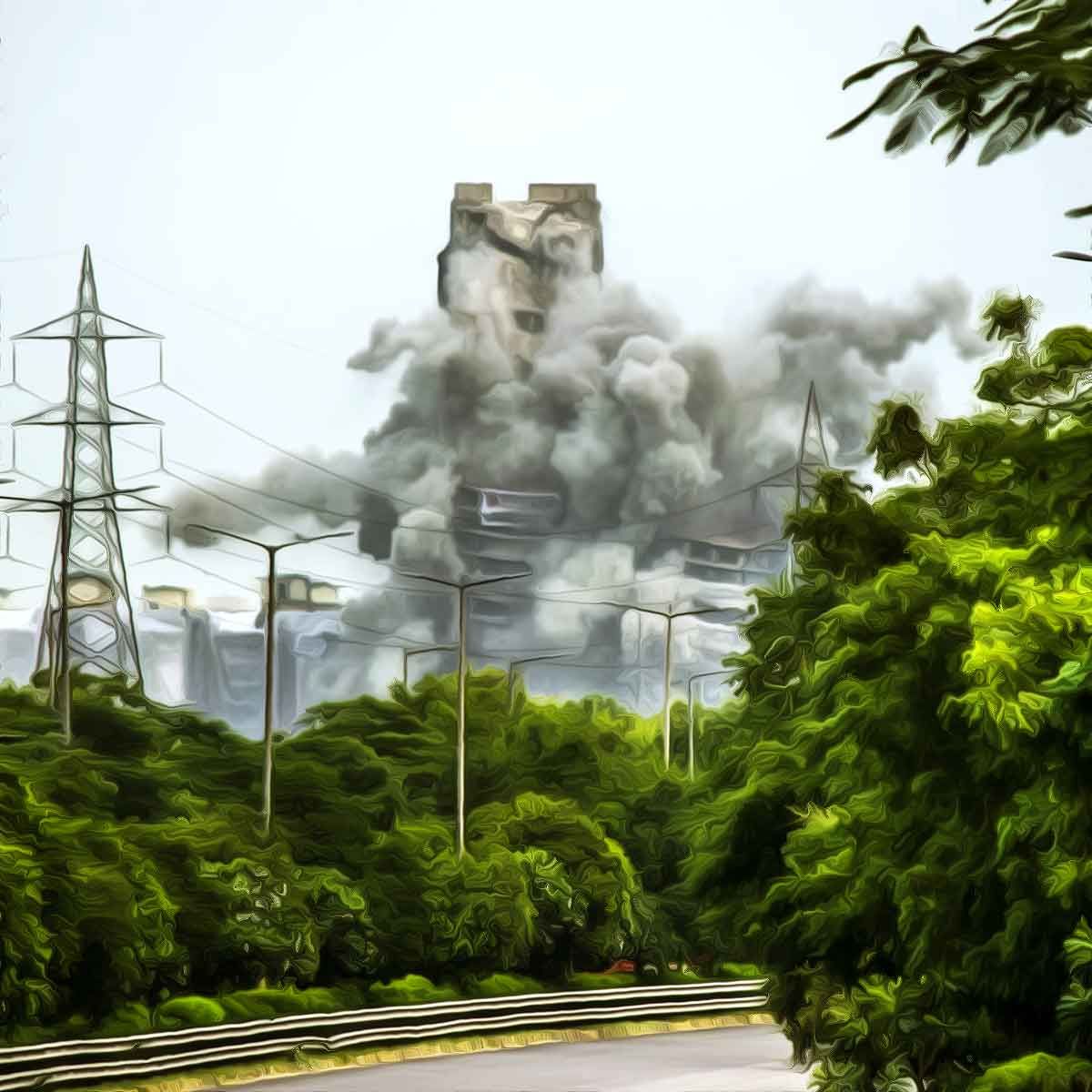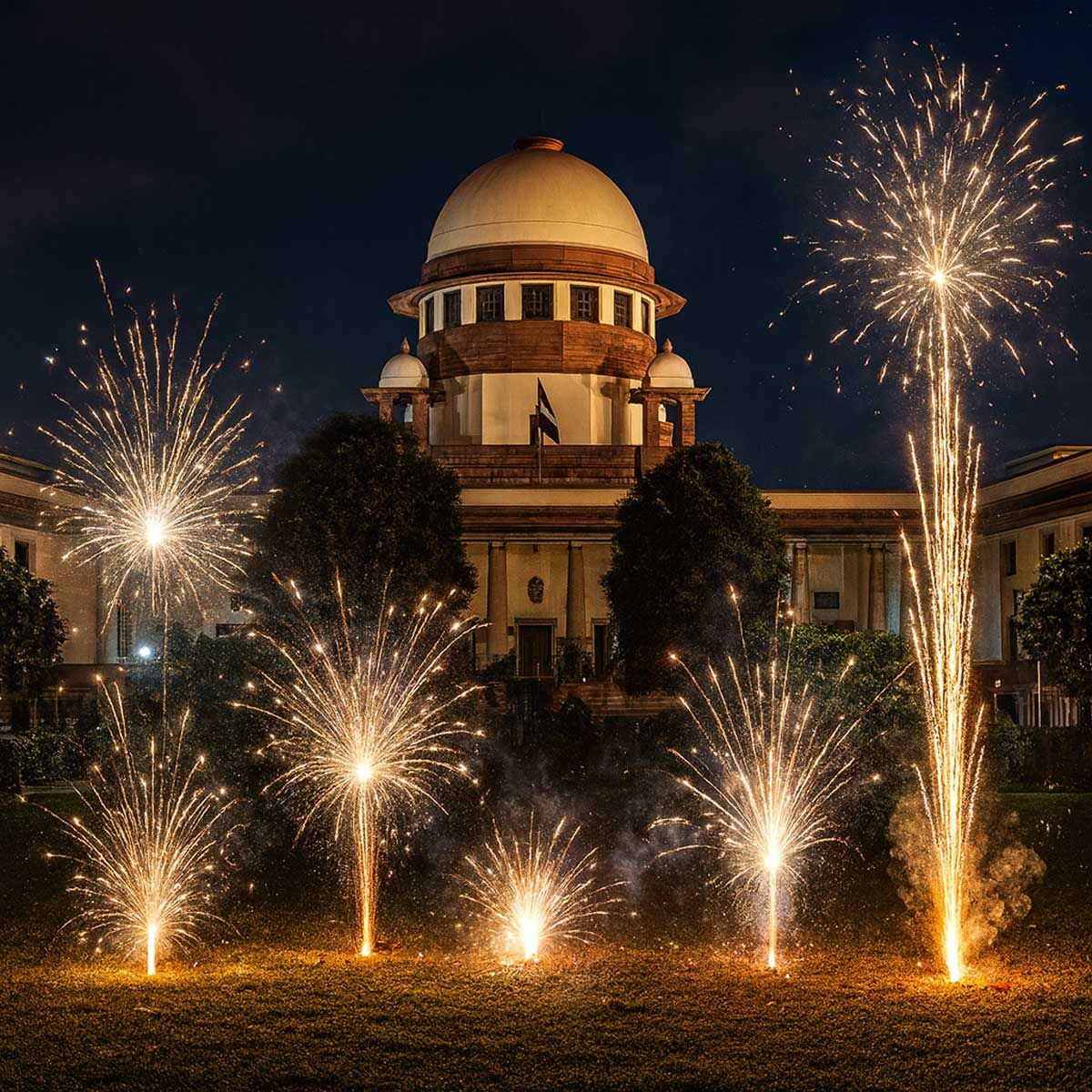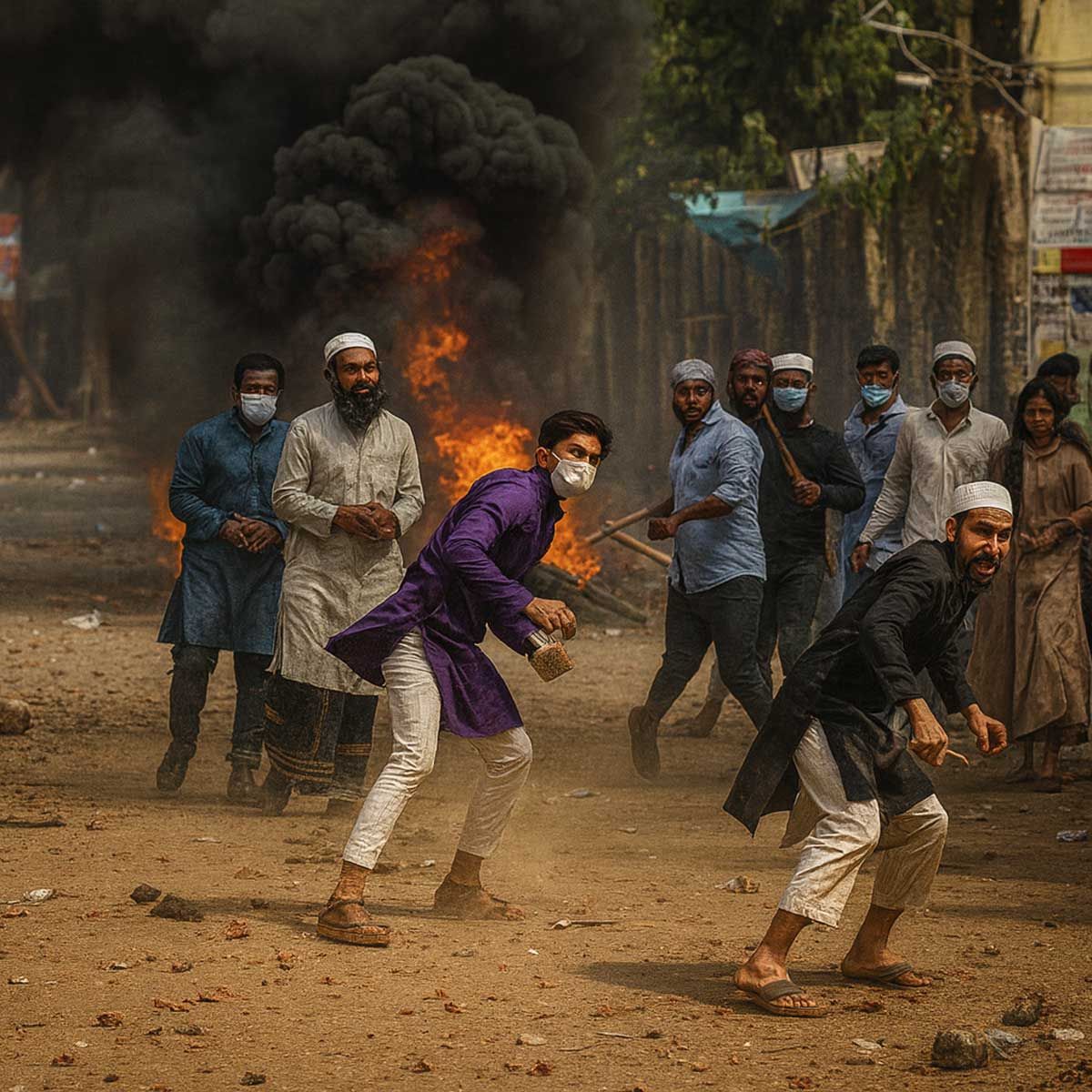More Coverage
Twitter Coverage
Satyaagrah
Written on
Satyaagrah
Written on
Satyaagrah
Written on
Satyaagrah
Written on
Satyaagrah
Written on
JOIN SATYAAGRAH SOCIAL MEDIA
“Take me to the place where they demolish buildings and plant new trees”: Ceyane and Apex, 100 meters Supertech Twin towers—taller than Qutub Minar reduced to dust in 9 seconds, 80k tonnes of construction & demolition debris to be cleared in 3 months

After much anticipation and a nine-year-long legal battle, the Supertech twin towers of Noida were reduced to rubble on Sunday (August 28). The towers, Ceyane (29 floors) and Apex (32 floors), that are part of the Emerald Court project of Supertech Ltd, were found to be in violation of multiple regulations regarding construction and were therefore demolished.
The highest structure in India to be demolished, the towers, comprising about 850 flats and located in Sector 93A near the Noida-Greater Noida Expressway, have a height of almost 100 meters — taller than the Qutub Minar. Preparations, from charging the buildings to clearing the area, were in full swing earlier this week. The resident welfare association (RWA) had directed residents of nearby apartment complexes, ATS Greens Village and Emerald Court, to evacuate by Sunday morning. According to the police, Emerald Court has 15 towers and ATS village has around 25 towers and four villas.
|
In a span of just 9 seconds, the two towers (named Ceyane and Apex) comprising 850 flats were reduced to rubble. Built as a part of the Emerland Court project, the high-rise buildings were located near the Noida-Greater Noida Expressway.
The demolition took 7 months of preparation, including 1 month of planning and 6 long months of onsite preparation. It was carried out using 3700 kg of explosives by two companies named Edifice Engineering based in West Bengal and Jet Demolitions from South Africa.
The surrounding area of 500 meters radius is marked as an exclusion zone, where no human or animal was allowed except for the members of the team in charge of the demolition. Apart from this, the police, a team of the National Disaster Response Force, eight ambulances, and four fire tenders will be deployed at the site.
|
The controlled implosion resulted in 80,000 tonnes of construction and demolition waste. About 50,000-55,000 tonnes of debris will be used to fill the site and the remaining will be shifted to a construction plant for processing. 4-meter-deep trenches have been dug in the blast area to contain the rubble. Water sprinklers and several other measures have been kept ready to reduce dust.
The New Okhla Industrial Development Authority (NOIDA) officials had assured to remove the rubble within a period of 3 months.
The preparations had begun with the removal of everything not part of the main structure of the towers, including all extra concrete. All the debris generated in this process was kept in the basement of the structures, to create cushions for the impact of the blasts. For the demolition, 9642 holes were drilled into the columns and shear walls of the towers, each having a diameter of 35 mm. Around 3700 kg of explosives were brought from a PESO-authorised magazine in Palwal to fill the holes, which were connected to the detonator. It is a mixture of dynamite, emulsions, and plastic explosives.
|
The entire demolition process was led by Joseph Robert Brinkkman, the CEO and MD of the South African company.
Why were Noida’s Supertech twin towers demolished?
Supertech was granted approval in 2005 by the New Okhla Industrial Development Authority (NOIDA) to build 14 towers with nine floors each, a shopping complex and a garden area. However, it revised its project in 2009 to include twin high-rise buildings — Apex and Ceyane. Even though the NOIDA authority approved the new plan, the Emerald Court Owners Residents Welfare Association (RWA) moved to the Allahabad High Court in 2012 alleging it was an illegal construction.
In 2014, the Allahabad High Court ruled that the towers were illegal and ordered demolition. The Noida Authority and Supertech approached the Supreme Court challenging this order. On August 31, 2021, the apex court upheld the ruling of the Allahabad High Court and ordered the demolition of the buildings.
The Supreme Court found the construction of the twin towers in violation of the minimum distance requirement.
It said the towers were built without complying with building regulations and fire safety norms.
|
It said the modification of the plan — removing the garden area to make way for the construction of Apex and Ceyane — was done without the consent of the flat owners, which violated the Uttar Pradesh Apartments Act, 2010.
The top court, in August 2021, while ordering the demolition of the illegally constructed towers, said it was built through “acts of collusion between the officers of NOIDA and company”, and sanctioned the prosecution of officials for violation of the Uttar Pradesh Industrial Area Development Act, 1976 and Uttar Pradesh Apartments Act, 2010.
Even though the Court ordered the demolition within three months, multiple delays resulted in setting the final date to August 28.
The demolition of Noida’s Supertech twin towers
The Supertech towers will be demolished via a ‘controlled implosion’, which means it will collapse after explosives are strategically placed and detonated to ensure minimal damage to the surroundings. The process behind the implosion includes the gradual weakening of critical supports of the building, i.e., removing the structures that will help resist the gravitational force. This will be achieved by numerous explosives placed within the structure. Usually, the explosives on the lower floors of the structure initiate the controlled collapse of the building.
The technique was used for the first time in 1773 to raze the Holy Trinity Cathedral in Waterford, Ireland, with 68.04 kg of explosives. It was recently used in India in the 2020 demolition of four luxury waterfront apartments in front of Vembanad Lake in Kochi’s Maradu for violating Coastal Regulation Zone regulations. The same technique can be used for the demolitions of bridges, smokestacks, towers, tunnels, and other structures, too.
Mumbai-based Edifice Engineering has partnered with South Africa’s Jet, the same team behind the demolition of the Maradu buildings, to demolish the Supertech towers.
One of the most time taking processes in a controlled implosion is the preparation to place the chemicals. For this demolition, the preparation took nearly seven months, including one month of planning and six months of onsite preparations, said Utkarsh Mehta, CEO of Edifice Engineering.
Around 3,700 kg of explosives have been infused into the two towers. Apex has 11 primary blast floors, where all columns on the floor have explosives, and seven secondary floors, where 60 per cent of the columns will be blasted. Ceyane has 10 primary blast floors.
According to Mehta, the main component used for the explosion is the emulsion that has superior rock crushing quality, generally used underground for heavy blasts and mines. He said they have used a lesser quantity of it in Supertech since the structures don’t require much. Apart from the emulsion, shock tubes that will direct blast waves and simulate actual explosions, and electric and non-electric detonators that will trigger the explosives, are also being used.
The event, which takes around 13 seconds, will leave behind approximately 80,000 tonnes of construction and demolition waste, of which 50,000 to 55,000 tonnes will be used for filling the site and the rest will be sent to a construction and demolition plant for processing.
There are several concerns regarding the demolition of Noida’s Supertech twin towers. The first is the amount of dust the demolition will generate.
The second is the clearing of the debris, even though officials have said the rubble will be cleared within three months.
Third, experts have raised concerns over windblown dust generated in the blast, which can remain in the air for weeks and cause health issues to people in the area. The Noida Authority has said they will provide water tankers, mechanical sweeping machines, and sanitation staff to control the dust menace. Officials have also promised air quality monitoring.
Gaurav Saxena, a resident of the Emerald Court, is leaving Noida for Nainital on Saturday night with his 65-year-old mother as he is worried about the fine particles that may remain in the air. Saxena plans to return to his flat on Monday but says he and his neighbors are hoping the plastic sheets put up to cover their windows and balconies will protect them. He also hopes rainfall will bring some relief.
Mehta, meanwhile, said, “We are expecting the dust to dissipate in 10 minutes. The moment it does, our team will inspect the site and check whether any explosives are remaining to explode. The settling of the dust is dependent on the wind direction and its strength.”
The impact of dust on the already bad air quality of Noida can’t be ruled out, said Delhi-based environmental activist and co-founder of New Delhi Nature Society, Verhaen Khanna. He said a more scientific method should be used to control the dust other than water spraying.
The authorities had also asked people in the surrounding areas to not come outside during the blast time. They sent messages asking residents in the area to keep indoors from 2 PM to 5 PM and to keep the doors and windows closed. The area also was declared a no-flying zone and using drones in the area during the blast was banned.
An exclusion zone of up to 50 meters radius around the blast site was created where no human or animal will be allowed, except the demolition team. Ambulances, fire tenders, police personnel, NDRF, and paramilitary teams were kept ready at the site.
India Today journalist Shiv Aroor, who lives in one of the two apartment complexes, had also evacuated his residence as per the advice of the Resident Welfare Association (RWA).
|
Journalist Tavleen Singh Aroor had earlier informed how parking lots were emptied and balconies were covered in thick plastic sheets.
|
Authorities will also be monitoring the air quality of the area. The residents of ATS Green Village and Emerland Court will be allowed to return to their apartments by evening.
Edifice Engineering officials had assured us that there will be no harm to the nearby buildings. They have said that the vibration in for ground due to the explosion will be 34 mm per second, while the buildings in the Delhi-NCR region that fall under Seismic Zone 5 are designed to withstand vibrations of 300 mmps. Edifice Engineering chief Utkarsh Mehta had said that the company has got Rs 100 crore insurance to cover any damage during the task, but they are confident that they won’t have to claim it.
Last year, the Supreme Court of India gave a green signal to the demolition of the Supertech twin flouting regulations and safety protocols. The high-rise buildings were constructed in violation of the Uttar Pradesh Apartments Act, 2010, and the Uttar Pradesh Industrial Area Development Act, 1976.
References:
opindia.com
indianexpress.com
 Support Us
Support Us
Satyagraha was born from the heart of our land, with an undying aim to unveil the true essence of Bharat. It seeks to illuminate the hidden tales of our valiant freedom fighters and the rich chronicles that haven't yet sung their complete melody in the mainstream.
While platforms like NDTV and 'The Wire' effortlessly garner funds under the banner of safeguarding democracy, we at Satyagraha walk a different path. Our strength and resonance come from you. In this journey to weave a stronger Bharat, every little contribution amplifies our voice. Let's come together, contribute as you can, and champion the true spirit of our nation.
 |  |  |
| ICICI Bank of Satyaagrah | Razorpay Bank of Satyaagrah | PayPal Bank of Satyaagrah - For International Payments |
If all above doesn't work, then try the LINK below:
Please share the article on other platforms
DISCLAIMER: The author is solely responsible for the views expressed in this article. The author carries the responsibility for citing and/or licensing of images utilized within the text. The website also frequently uses non-commercial images for representational purposes only in line with the article. We are not responsible for the authenticity of such images. If some images have a copyright issue, we request the person/entity to contact us at This email address is being protected from spambots. You need JavaScript enabled to view it. and we will take the necessary actions to resolve the issue.
Related Articles
- "Digital fluency can accelerate progress": RBI Governor, Shaktikanta Das launched 3 key digital payment initiatives at the Global Fintech Fest 2022 - RuPay Credit Card on Unified Payments Interface, UPI Lite, and Bharat BillPay Cross-Border Bill Payments
- Saghir Khan have been granted protection from arrest by Allahabad HC: Earlier he had incited Muslims to seek revenge in case Ayodhya verdict comes in Hindu’s favour
- Ad featuring Aamir Khan hurts Hindu sentiments: BJP MP Anantkumar Hegde writes to CEAT Tyres to make ad showcasing nuisance of namaz on roads, loudspeakers in mosques
- India successfully carried out the test firing of a new missile of the Agni series known as Agni-Prime
- Kerala High Court slams state govt’s over 80% minority scholarship quota for Muslims, says legally not sustainable: Details
- "Your beliefs don't make you a better person, your behavior does": Shocking incident in Delhi's Dwarka as women pilot and her husband had to face mob outrage for employing and torturing a 10-year-old girl, Child abuse and legal violations exposed
- ‘Will they give livelihood 100 million farmers’: Amul MD responds to PETA India for asking them to use ‘vegan milk’ after losing a case to Amul
- Haryana: Man burnt alive to make him ‘martyr’ against farm laws, villagers demand security from ‘farmers’ at Tikri border
- 130 attackers arrested in Noakhali, Bangladesh for violence against Hindus: So far out of thousands unnamed Islamists booked
- Primary school made boys to wear skirts to promote ‘gender equality’: United Kingdom
- Highest annual Foreign Direct Investment inflow of USD 83.57 billion recorded by India in FY21-22, IT sector bags the largest share: proves that India is growing as a desirable destination for international investment
- 5 lakh kg of temple jewellery has been melted so far, DMK government planning to melt even more
- Once again lampooning Hindu religious sentiments, TN HRCE approved a project to build a fish market on temple land using temple money
- Not just wanting to use hospitals to convert Hindus, IMA Chief Johnrose Jayalal also harbours visceral hate for PM Modi
- “Life is pleasant, death is peaceful. It’s the transition that’s troublesome”: Congress chief Sonia Gandhi's mother Paola Maino passed away at her home in Italy, Prime Minister of India Shri Narendra Modi and President of India sent their condolences




























